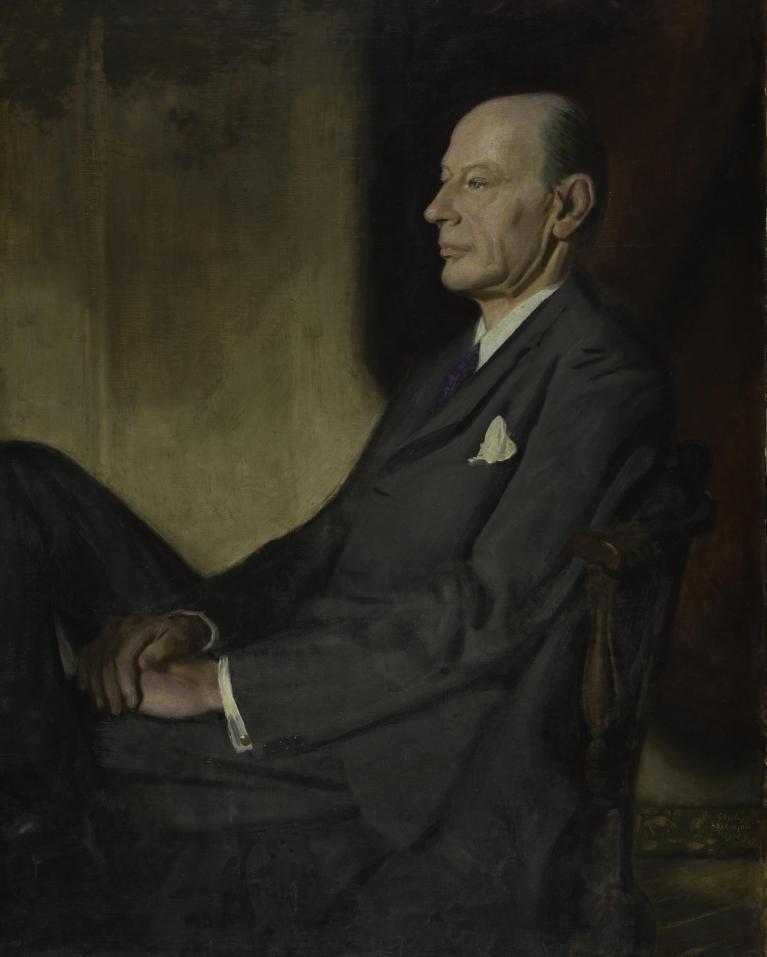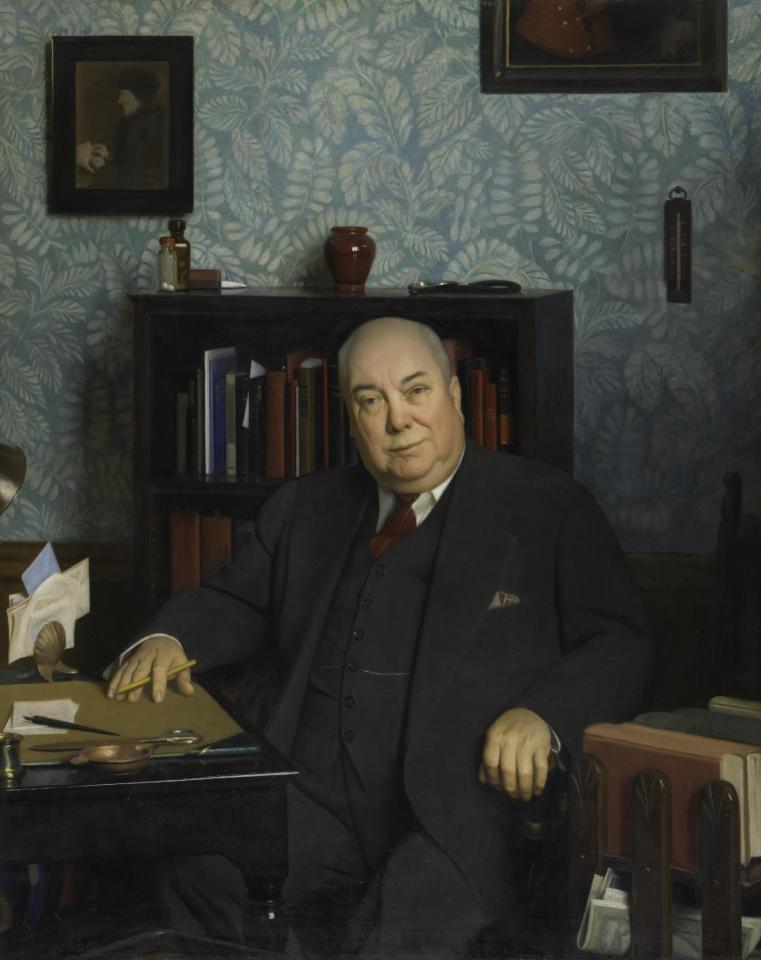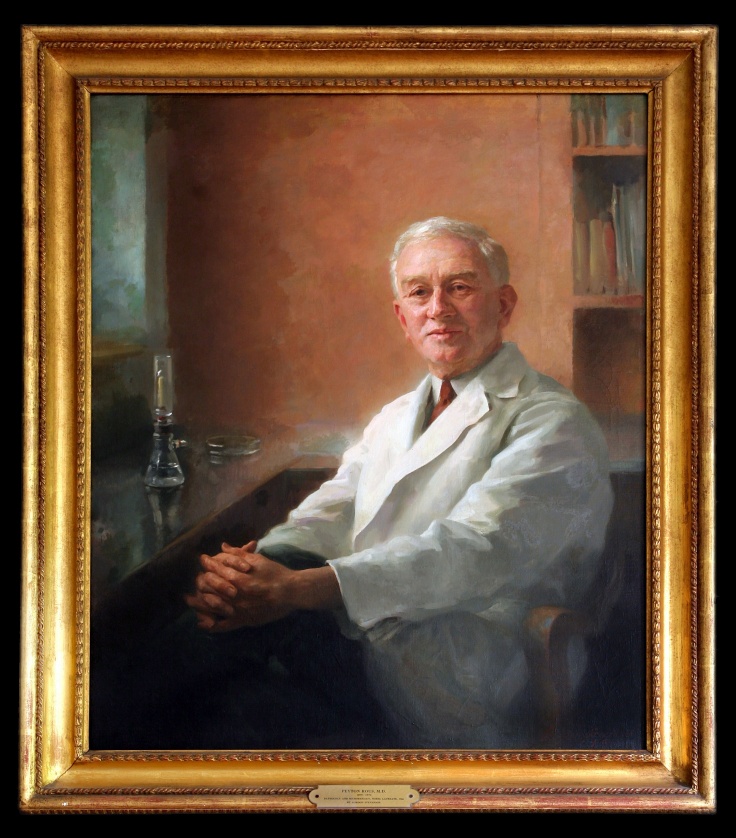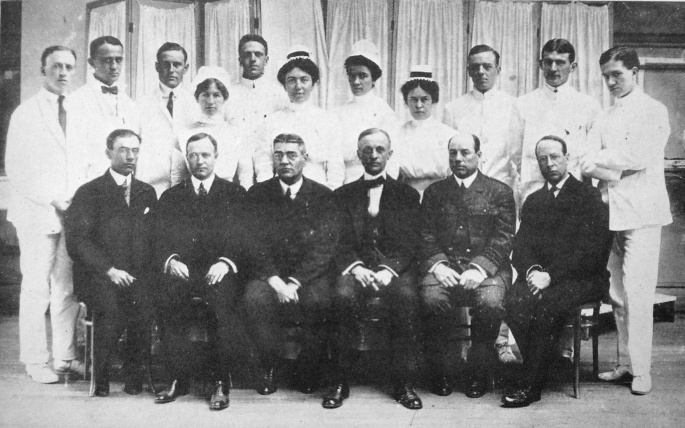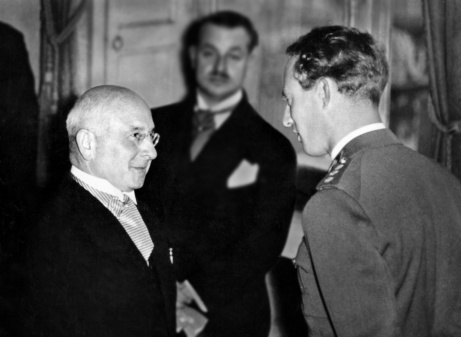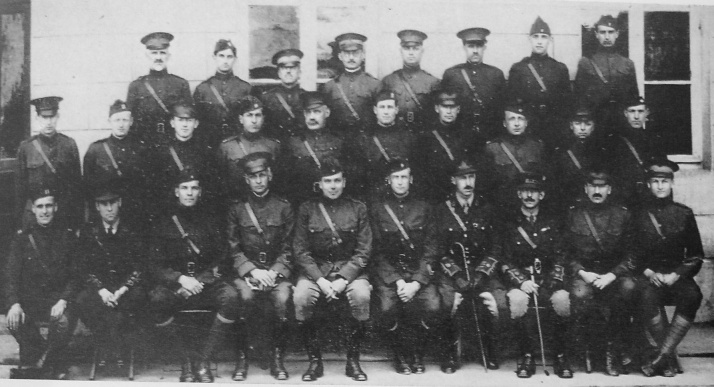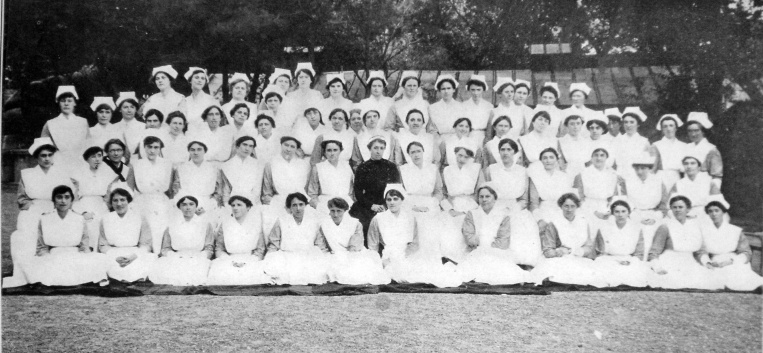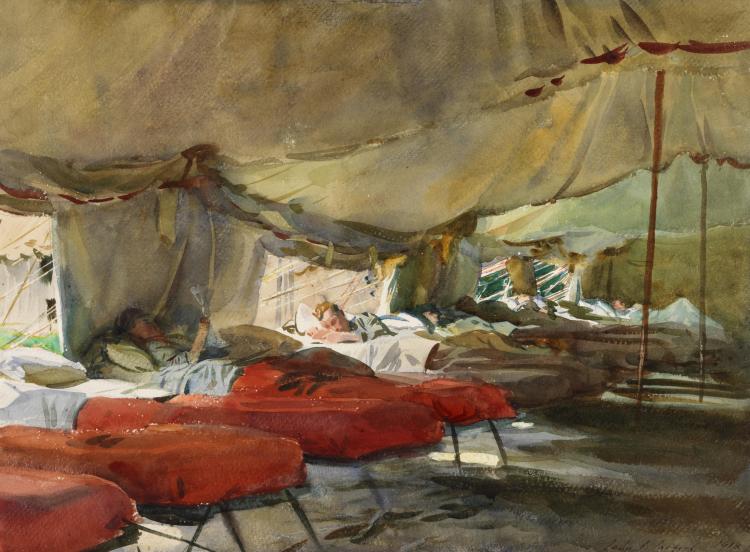SUMMARY
In 1894 Ulsterman and pathologist Almroth Wright described the citation of blood. Twenty-one years later it was introduced into wartime and clinical practice. Harvard Medical School had a large part in providing Colonel Andrew Fullerton, later Professor of Surgery, Queen's Belfast, with the intellectual and practical help for the Allies to deploy blood on the post-Somme Western Front and in Salonika. The key investigators and clinicians were Americans and Canadians who with Fullerton and Wright instructed the Allies. The key enablers were two Harvard-trained surgeons surnamed Robertson—Oswald H. (“Robby”) and L. Bruce (no relation). Physician Roger I. Lee of Harvard, surgeon George W Crile of Cleveland, Peyton Rous of the Rockefeller Institute and Richard Lewisohn of Mount Sinai Hospital, both located in the Upper East Side of New York City, played key roles.
By Armistice in 1918, indirect citrated nutrient-enhanced blood transfusion was widely used by the Allies. Geoffrey Keynes was taught the techniques of blood transfusion by Dr. Benjamin Harrison Alton of Harvard at a Casualty Clearing Station near Albert at the time of the Battle of Passchendaele. Professor “Robby” Robertson, DSO, Sir Geoffrey Keynes and Sir Thomas Houston established blood banking.
INTRODUCTION
On July 14, 1894 the British Medical Journal published Ulsterman Almroth Wright's1,2 description of the citation of blood. Development and deployment of blood transfusion was advanced by surgical scientists trained at Queen's Belfast, Harvard, and Johns Hopkins. We describe the cooperation between these institutions in the development of techniques for human blood transfusion. The use of citrates to allow storage of human blood for indirect transfusion took 21 years from 1894 to develop. Why so long?
PRE-WORLD WAR I
Almroth Wright visited William H. (“Poppy”) Welch's Department of Pathology at Johns Hopkins in Baltimore at the time of Wright's publication on the citation of blood. Welch was later to become the eminence grise of American Medical Science, President of the U.S. National Academy of Sciences, and chairman of the Board of Directors of Research of the Rockefeller Institute (later University) in New York City, and plenipotentiary enabler of American Surgeon General William Crawford Gorgas in World War I3.
Landsteiner in 1901 described human blood groups4 (Fig. 1), Jansky different group incompatibility in 19078 and Moss isoagglutinins and isohaemolysis in 19109,10. Their American contemporary, George W. Crile, described and investigated human direct artery to vein blood transfusion11 and was soon after visited in Cleveland, Ohio by Berkeley Moynihan, later Lord Moynihan12. George W. Crile11,13,14 Moynihan and Andrew Fullerton15–20 of Belfast were excellent technical surgeons who mastered dissection of the radial artery of the donor who was laid alongside the isolated major vein of the patient, generally a cephalic at the elbow. The artery was connected to the vein. Measurement of transfusion volume was difficult. On adverse reaction the donor's artery was clamped13.
Fig 1.
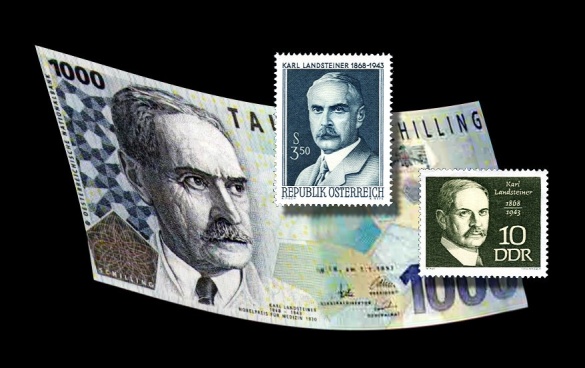
Collage of commemorative postage stamps and Austrian thousand-schilling note honoring Karl Landsteiner (1868-1943), by Lubush Stepanek, from the collection of Rockefeller University, New York, NY, and reproduced with the permission of the Trustees. Landsteiner was born in Vienna of Jewish parents, and graduated from the University of Vienna Medical School in 1891, already having published on the constitution of incinerated blood. He then trained under Hantsch of Zurich, Emil Fischer at Würzberg and Bamberger of Munich—five years as a chemist5. Landsteiner then became a pathologist and published extensively on the transmission of syphilis and poliomyelitis. He journeyed first-class by train with inoculated monkeys to the Pasteur Institute in Paris5. Peyton Rous, his colleague at the Rockefeller Institute, has written, “The fate of Landsteiner's effort to call attention to the practical bearing of the group differences in human bloods provides an exquisite instance of knowledge marking time on technique. Transfusion was still not done because (until at least 1915), the risk of clotting was too great”6. Between 1915 and 1921 Landsteiner's papers, many in German and some in Dutch, were at last frequently read and he accepted appointment as a member of the Rockefeller Institute. He built his family a house on Nantucket Island, Massachusetts, but after a few years “summer people” began to press near on their way to the lighthouse. The Landsteiners then moved to Newfane, Vermont, and Karl commuted by train to New York City. In 1939 Landsteiner became a Member Emeritus of the Rockefeller Institute, “an immaterial change”6, and he went on to mentor Linus Pauling on “The Nature of the Chemical Bond”6. Pauling liked to say he was given by Landsteiner, “The best four day course in immunology in the history of the world”6. Just after having completed another edition of The Specificity of Serological, Reactions7, KL died in 1943 of a coronary obstruction; his beloved wife survived but a few months. Their son, a graduate of Harvard Medical School, became a renowned surgeon in Boston5.
On July 24, 1912 the first perioperative blood transfusion at the Massachusetts General Hospital was conducted by Drs. C. Alan Porter, Henry Marble and Adams Leland using a paraffinated collection vessel and delivery cannula. This transfusion was untoward as was the accompanying operation21.* The previous month George R. Minot22 (Fig. 2) had graduated from Harvard Medical School and been appointed House Officer at the MGH24. In 1913, Dr. William E. Ladd's team at Boston's Childrens’ Hospital performed what was claimed to be the first truly therapeutic indirect blood transfusion, on a boy with generalized peritonitis and anaemia25. At this entirely successful procedure, Dr. L. Bruce Robertson, graduate of the University of Toronto and its Medical School was one of the two surgical house officers working under Dr. Ladd26. Contemporaneously, Oswald H. (“Robby”) Robertson (Fig. 3) was a Harvard Medical School student who also worked in Roger I. Lee's (Fig 4) laboratory, and in the Homer Wright Pathology Laboratories of the Massachusetts General Hospital, where he became an intern in 191330,32. Also working in this laboratory on blood coagulation and transfusion at this time were George R. Minot and Paul Dudley White, later to become President Eisenhower's cardiologist33. Oswald H. (“Robby”) Robertson married a nursing colleague of L. Bruce Robertson's from Boston Children's Hospital30.
Fig 2.
George Richards Minot (1885-1950). Oil on canvas, dimensions: sight: 126 × 100.5 cm (49 5/8 × 39 9/16 in.), by Charles Sydney Hopkinson, 1943. Harvard Art Museum, Fogg Art Museum, Harvard University Portrait Collection, Gift of the former students and friends of Dr. Minot to the Medical School, 1948, HNA 70. Photo: Junius Beebe © President and Fellows of Harvard College. G.R. Minot was born in Boston, to which his family had emigrated from Saffron Walden in 1630. His father, James Jackson Minot, was a physician on the staff of the Massachusetts General Hospital, and his mother a Whitney23. An early published lepodopterist, he graduated from Harvard College and thereafter its Medical School in 1912. Minot trained at the Massachusetts General Hospital and then at Johns Hopkins Hospital and Medical School under W.S. Thayer andW.H. Howell. In 1915 he was appointed as a Staff Physician at the Massachusetts General Hospital, and on June 29th, 1915 married Marian LinzerWeld. His Nobel Prize biography states “Minot early became, when he was a medical student, interested in disorders of the blood… Further he studied the coagulation of the blood, blood transfusion, the blood platelets, and the reticulocytes…”23. Minot's Nobel lecture of December 12, 1934 is a fascinating accountof his work as a 1910 Harvard Medical School student, “In my father's wards at the Massachusetts General Hospital” that led to the development of liver therapy in Pernicious Anemia,” and concluded “Thus, upon the foundations, laid by previous investigators, do medical art and science build a structure which will, in its turn, be the foundation of future knowledge”24.
Fig 3.
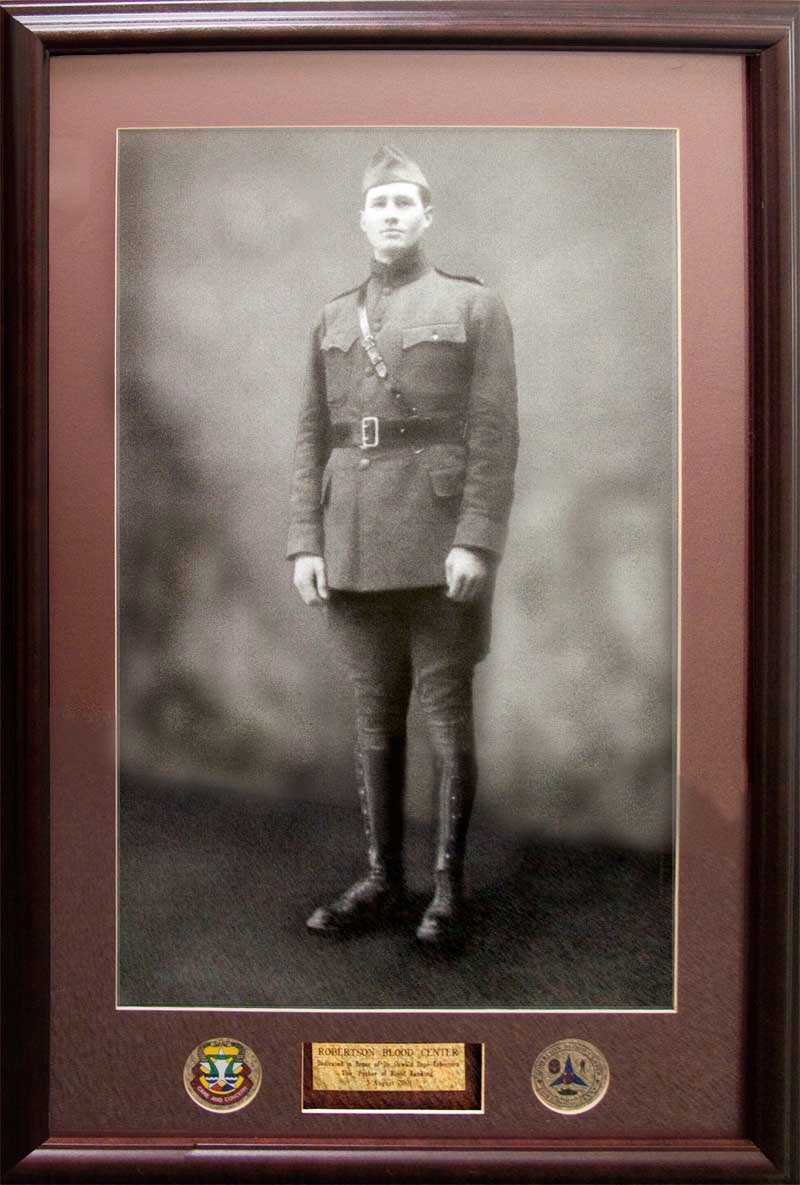
Oswald Hope (“Robby”) Robertson (1886-1966). Photograph from the U.S. National Archives, Washington D.C. , courtesy of the U.S. Department of the Army, Surgeon General, Armed Services Blood Program Office, Robertson Blood Center, Fort Hood Texas. O.H. Robertson was born in Woolwich, England but moved to California's San Joaquin Valley at the age of 18 months. He graduated from Polytechnic High School in San Francisco. After study in Germany he entered the premedical course at the University of California in 1906. In 1910 he obtained his M.Sc. before transferring to Harvard Medical School. Winner of the Dalton Scholarship at the Massachusetts General Hospital, he became an intern there in 1913-14. After his house officership he was appointed an Assistant in Bacteriology and Pathology at the Rockefeller Institute, in Peyton Rous' department27. He was the creator of the World's first blood bank in World War I in Belgium and France; later Professor of Medicine and Department Head at Peking Union Medical College, and from 1927 at the University of Chicago. Elected to the U.S. National Academy of Sciences in 194327, Oswald H. Robertson ended his career as Professor of Zoology at Stanford, specializing in the study of Californian habitats and especially the endocrinology of Pacific salmon28,29. King George V elected him, an American, a DSO in 191830.
Fig 4.
Roger Irving Lee (1881-1965) Oil on canvas, dimensions: actual: 130.81x 107.95 cm (51 ½ × 42 ½ in.), by Robert Hale Ives Gammell, 1954. Harvard Art Museum, Fogg Art Museum, Harvard University Portrait Collection, Gift of Dr. Roger I. Lee to the Harvard School of Public Health, 1954, H547. Photo: Junius Beebe © President and Fellows of Harvard College. Lee was a graduate of Harvard College and Medical School, trained at the Massachusetts General Hospital, where he became an attending physician. He there conducted research on blood with Paul Dudley White, George R. Minot and O.H. Robertson. Appointed Professor of Hygiene, Harvard University, he became Chief of Medical Service, U.S. Army Base Hospital Number 5. On February 28th, 1918, he succeeded Colonel Patterson as Commanding Officer of U.S. Army Base Hospital No. 5. On September 6th, 1918 he was detached for duty with the American Expeditionary Force as Senior Divisional Consultant in General Medicine, attached to the 3rd Corps31.
ULSTER CONTRIBUTIONS
During mobilization of the British Empire for World War I the British War Office asked the Royal Colleges of Surgeons of England and of Ireland each to name chief consulting surgeons for the British Expeditionary Force to France. The English College named the Queen's professor Thomas Sinclair34,35 and the Irish College nominated Andrew Fullerton, also of Queen's15–20,34. These distinguished surgeons were acceptable to the Canadians, French and the United States. P.T. Crymble34,36,37, later to be Andrew Fullerton's successor as Queen's Professor of Surgery in 1933, was brought as Head of Chest Surgery for the British 13th General Hospital, which was visited by William H. Welch in August 19163, and later was merged with Harvard's U.S. Fifth General and based in Boulogne. Some histories refer to this base hospital, which also contained visiting Ulster pathologist Thomas Houston, and Norman R. Keith as Almroth Wright's hospital, others as Harvey Cushing's31,38.
After 1914, British authorities asked the United States to send qualified medical and surgical personnel to the Western Front. This was accomplished, first by Crile's Case Western Hospital, succeeded by Harvard and many other staffs formed from U.S. medical schools during the two and a half years before the United States entered World War I on April 6th, 191739,40.
ANTE-BELLUM UNITED STATES
Roger I. Lee and Richard Cabot of Harvard on April 5, 191541 suggested that with Welch's Carnegie funding, Oswald (“Robby”) Robertson should proceed to work on further blood transfusion problems in Peyton Rous' (Fig. 5) laboratory at the Rockefeller Institute in New York44–54where William Welch was a prominent trustee3. Rous had been a student of Osier and Welch at Johns Hopkins43. The Rockefeller Institute is within easy walking distance of Mount Sinai Hospital where Richard Lewisohn's team were investigating and extending Crile and Moynihan's use of blood transfusion in human surgery55–57. Lewisohn had graduated as a physician from Freiburg in 1899 and emigrated to New York City in 1906, where he became a surgeon58.
Fig 5.
Francis Peyton Rous (1879-1970), Oil on canvas by Gordon Stevenson (1892-1984), a student of John Singer Sargent. From the collections of Rockefeller University, and reproduced with the permission of the Trustees. Born in Texas, his father who was a Baltimorean of English descent, died young. His mother was left with three young children and did not return to Texas. Peyton went as a scholar to Johns Hopkins where he scraped his finger during an autopsy, and a “corpse tubercle” formed. His axillary glands were removed and he returned to Texas. He was sent west from there as a ranchero; for a year he never had a bed. He returned, having lost a year, and graduated from Johns Hopkins Medical School in 1905 and was appointed an instructor in the University of Michigan Department of Pathology. He was sent to Dresden for 1907 and in 1909 joined the research team of the Rockefeller Institute. After only a few months he was asked by Dr. Simon Flexner to be his successor as director of the Laboratory for Cancer Research at the Rockefeller Institute, where he remained for 61 years35. Both Peyton Rous and his son-in-law Alan Hodgkin42 received Nobel Prizes and were Fellows of the Royal Society43. A late addendum to his 1966 Nobel Biography states “Rous has not mentioned the pioneer research on blood transfusion with J.R. Turner and O.H. Robertson which led to the establishment in 1917 of the world's first blood bank near the front line in Belgium”42. Rous was a Fellow of Trinity Hall, Cambridge.
After the declaration of World War I on August 3, 1914, Roger I. Lee's MGH surgical colleague Beth Vincent (Fig. 6) was the instigator of blood transfusion of the wounded. This he did as a volunteer in Paris using the Harvard Kimpton paraffin-coated transfusion apparatus21,61. Alexis Carrel (Fig. 7), already a Nobel Laureate in 1912, followed Vincent's example, also in Paris, but used direct artery to vein anastomosis, as did fellow volunteer in Paris, George W Crile11,13,14.
Fig 6.
The Harvard Unit at the American Ambulance (World War I Hospital) at Lycee Pasteur Neuilly, Paris, April 1915. Standing: Wilson, Benet, Barton, Rogers, Coller, Cutler, Smith-Petersen. Nurses: Wilson, Cox, Martin, Parks. Seated: Boothby, Beth Vincent, Greenough, Harvey Cushing, Strong, Osgood39. Harvey Cushing's journal today fills nine bound volumes (one million words) in his library at Yale. Elliott Cutler succeeded Harvey Cushing as Moseley Professor of Surgery at Harvard, and during World War II was on the Allied Surgical Consultants committee with Sir Ian Fraser59 and my father60.
Fig 7.
Alexis Carrel receives the Order of Leopold from King Leopold III of Belgium, June 19, 1937. From the Rockefeller Archive Center and reproduced with their permission. Alexis Carrrel was born at Lyons, France on June 28th, 1873. His father died when he was very young and he was educated by his mother. In 1889 he became Bachelor of Letters at the University of Lyons, then B.Sc. (1890) and M.D. (1900). In 1902 Carrel began experimental work on transplantation at Lyons, but two years later he emigrated to the U.S. and worked in the Physiology Department of the University of Chicago for two years. In 1906 he was called to the Rockefeller Institute, where he remained for 33 years62, apart from service as a Major in the French Army Medical Corps with command of a Rockefeller-supported Base Hospital at Compiègne39. Carrel died in Paris on November 5, 194462 Carrel received the Nobel Prize in 1912 for his work on operations on blood-vessels and anastomoses in man62. In his Nobel Lecture, Carrel states ,“In his admirable method for the transfusion of the blood, Crile first used suture for the anastomosis of the blood vessels. Although the suture is difficult in very small vessels, it has, nevertheless, been used with success in the transfusion of the blood in infants. The study of the circulation of the blood through metallic tubes has led to a simpler technique… which will increase the efficiency of Crile's method“63.
L. Bruce Robertson joined the Canadian Army in August 1914, and used indirect techniques developed by his teacher surgeon William E. Ladd of Boston Children's Hospital, and multiple syringe injections of blood64–67. By the early autumn of 1915, Harvard trained surgeons of the American Women's War Hospital in Oldway House, Paignton, S. Devon were routinely giving blood transfusions to soliders wounded in France68. In 1915 citrated blood techniques began to supercede the use of Kimpton paraffin-coated apparatus46,48,49,55,56.
Harvey Cushing, having just succeeded his former MGH chief, Maurice Richardson, as Moseley Professor of Surgery, left Boston on Thursday, March 18th, 1915. He arrived in Paris, France on April 1, 1915, to take over the converted Lycee Pasteur from George W Crile's Case Western Hospital, Cleveland. On April 11, 1915, Harvey Cushing went to the 2nd (French) Army and spent the next couple of days at Compiegne with “Alexis Carrel, an Americanized Frenchman [who] is not to be confused with a Gallicized Marylander, M. Charles Carroll de Carollton… who arrives driving his own militarized car…”39. Cushing writes that Carrel is “backed by Rockefeller money with an admirable staff” over which “Madame Carrel rules as “general tyrant”, according to [Alexis] her husband.”39 Carrel and Cushing then visited a neighboring British hospital and were not impressed.
Having finished his Harvard Lycee Pasteur stint, Cushing went to the British Number 13 General Hospital during the Second Ypres battle; 720 to 900 wounded with hard-worked competent doctors and nurses. Dinner there, on May 3rd, 1915, was with Sir Almroth Wright, “as amusing and chatty as he was iconoclastic”39. On May 5th, 1915, Cushing visited Number 8 Field Ambulance at La Clytte, 3 miles from Ypres, where Captain Henry Bazett, Demonstrator of Pathology, Oxford University, was in charge39. Bazett co-authored with Colonel Andrew Fullerton, as Principal author, and Bazett's Oxford boss Professor Georges Dreyer, M.D., an influential article on techniques of direct blood transfusion15.
On May 6th, 1915, Cushing went to England to stay with the Osiers at Oxford and meet Sir Walter Morley Fletcher, Secretary of the Medical Research Committee, (later Council (MRC)). They discussed publications, including on blood transfusion, and made further plans for the American University project to deploy personnel from 20-22 U.S. medical schools to France. On Saturday, May 8th, Cushing embarked on the steamer St. Paul which sailed through the wreckage and floating bodies from the Lusitania, sunk by U20, which were “strewn for some twenty miles or more“39.
Roger I. Lee also went to France in 1915 but not with Cushing. The 1915 mission of this Harvard Medical Unit was to staff a British base hospital Number 22 at Dannes-Camiers, not far from British Number 13 at Boulogne. The Number 22 unit was under the professional leadership of Dr. Edward H. Nichols31,69, a Harvard Professor of Surgery, later to command the U.S. Boston City Hospital Unit. Lee states “Thanks largely to Sir Almroth E. Wright and his typhoid inoculation, typhoid was not the terrible specter it had been in the United States Army in the Spanish-American War less than twenty years before” 31. Dr. C. Allen Porter, a senior MGH surgeon, had now almost 3 years of experience of blood transfusion and was an old friend of Lee. Together they went to the front where Lee was wounded on the chin by a German with “a good eye”31. “By this time Porter and I were due home” at Harvard31. They returned with a conviction that blood transfusion had to be expanded and widely deployed up to the Allied front line31.
USA NOW AT WAR
When Lee returned in June 1917 again to Dannes-Camiers, this time with Harvard's 5th U.S. Base Hospital (Fig. 8), “We promptly got down to work. Due to the experience of some of us in the first unit, the new unit was much better prepared. Oswald (“Robby”) Robertson, Arlie V Bock21,70,72† and I (Roger Lee) tried to spread the gospel of the necessity of blood grouping to make blood transfusion safe”31. “…In a special meeting on transfusion, a ‘well-known American’ was pooh-poohing blood typing…He went on to demonstrate, and the poor devil of a patient died then and there”31. So the Oswald Robertson system of indirect transfusion of citrated Rous-Robertson-Turner nutrition enhanced stored cross-matched blood won out, later to be improved by the Geoffrey Keynes drip chamber73. Many, many medical personnel were trained in this system and questionnaires had to be completed. The experience and reputation of Fullerton, Sinclair, Carrel, Crile, Moynihan and Cushing supported Oswald (Robby) Robertson's bottled blood against the use of saline and the gum acacia supported by some English surgeons and Harvard's Professor of Physiology, Walter B. Cannon31. Lee writes, “Cannon and I had rather a tiff about it but his gum acacia solution was poisonous to humans“31.
Fig 8.
Some of the officers of U.S. Base Hospital Number 5 at Boulogne, 1917. The middle row: Capt. J.L. Stoddard, Capt. H.M. Clute, Capt. Arlie V Bock, Capt. H. Lyman, Capt. A. Hepburn, Capt. Oswald (“Robby“) Robertson, Capt. G.P. Denny, Capt. S.C. Haney, Capt. IP. Wall, Capt. G.A. Horrax. Front Row: Capt. IS. Forbes, Capt. Leonard Colebrook F.R.S., R.A.M.C., Maj. H. Binney, Maj. Prof. Harvey Cushing, Commanding Officer Designate Maj. Prof. Roger I. Lee, Maj. H. Binney, Maj. Albert E.B. Wood, R.A.M.C., Quartermaster Capt. C.E.T. Richmond, R.A.M.C., Capt. F.R. Ober, Chaplain Malcolm E. Peabody31.
When Lee was made commanding officer of Harvard's 5th Base Hospital he “…expostulated vigorously, because this unit had been instigated by Harvey Cushing and Cushing had always referred to it as his child, his creation…I [Lee] must say that everyone was very nice about it. Harvey Cushing had a few squirms; otherwise he wouldn't have been Harvey Cushing”31. “He said it was too bad, that they ought to have picked out our top sergeant for the job” 31. “To be sure, the sergeant is stupid, ill-mannered, and a bit of a drunk, but well suited for the job”31. Cushing and Lee continued as friends until Cushing's death. “But when he [Cushing] got up a sort of reunion of our unit, he just didn't send me an invitation,” writes Lee31.
From 1931 to 1953, Roger I. Lee served on the Harvard Corporation—the other four fellows had all been trained in the law. The five Harvard fellows are self-perpetuating in perpetuity and everyone at Harvard is advisory to them—so Cushing may not have wished to draw attention to his friend Lee again becoming his ‘commander’.
Harvey Cushing and Roger Lee were both extremely fond of Oswald H. Robertson whom they both knew as “Robby”. Their diaries and letters constantly praise “Robby” and his accomplishments, and note that he was the nephew of Major General Sir James Murray Irwin, KCMG, CB, MD, (TCD), born in Manorcunningham, Co. Donegal31,38,39,74. Cushing, in particular, met many of the allied generals in France and England: he even talked à deux to Colonel Edward House, Woodrow Wilson's emissary and to King George V Cushing was threatened with a British court-martial for his criticisms in his letters of many, chiefly English, not Irish, surgeons. He frequently mentions favourably Colonel Andrew Fullerton. “Black-Jack” Pershing, the American Commander in Europe squashed the threatened court-martial of Cushing, and the Royal College of Surgeons of Ireland summoned Cushing to Dublin and gave him an honorary fellowship39. Queen's Belfast followed with an honorary M.D. Cushing, Lee and Oswald H.“Robby” Robertson liked and especially admired Andrew Fullerton and Professor P.T. Sinclair. O.H.“Robby” Robertson praised them to his maternal uncle then the director of Medical Services, 3rd Army39,74. Irwin's KCMG was awarded for diplomatic service 1915-18 in France. Irwin and his sisters were children of the Raymoghy manse at Manorcunningham, Co. Donegal.
MORE CANADIAN CONTRIBUTIONS
The Boston and Toronto Children's Hospitals-trained Canadian Major Lawrence Bruce Robertson served in France in the Canadian Corps of the 3rd Army. He arrived in France in September 1915 and in June 1916 he published an article in the British Medical Journal, “The transfer of whole blood: a suggestion for its more frequent employment in war surgery“66. L. Bruce Robertson, while in France, did not cross-match. He was deployed as a transfusionist to the Second Canadian Casualty clearing station in early 1916. In the 36 cases, L. Bruce Robertson described in the BMJ he had three fatal transfusion reactions66.
In December 1914, Edward Archibald of McGill had visited George W. Crile in Cleveland just before the latter's departure with his hospital for Paris. The Archibald family had lived in Londonderry, Ulster, from approximately 1640 to 1740 when they emigrated to Londonderry, New Hampshire, then to Nova Scotia, and finally to Montreal. Crile and Moynihan of Leeds were at that time the only surgeons with much experience of direct human blood transfusion. Archibald enlisted on April 7th, 1915. He was in France until October 1916. Of the eight patients he describes in advocating blood transfusion, 6 died, one benefitted and survived, the other survived despite a severe haemolytic reaction75.
The main advance Archibald supported was the use of citrated blood. Archibald later became President of the American Surgical Association. There exists a warm obituary of Edward Archibald from Professor Wilder Penfield OM, a member of Professor Archibald's Department of Surgery at McGill76.
Norman Guiou went to France on June 16th 1915 as a McGill medical student with the rank of private. Guiou, on October 27, 1915, saw Captain WB. Howell, later a famous Canadian anaesthetist, give a pint of his own blood while he was giving an anaesthetic. Guiou soon returned to Montreal to finish his M.D.77.
After O.H. “Robby” Robertson's urging, the Canadians moved from direct syringe or artery to vein anastomosis transfusion to using O.H. “Robby” Robertson bottles of stored citrated blood at Dressing Stations. Back at the ambulance units, Guiou and his men made compartmental wooden cases two feet long and fourteen inches high. To keep needles sharp, a glass blower designed a stone apparatus that led to standardization by the Allied Medical Research Committee. By Armistice both the American and Canadian forces were allowing the complete procedure of transfusion from Robertson bottles by dressers who were generally of the rank of acting sergeants, and by Harvard trained nurses who were widely deployed to other Allied Units78,79 (Fig. 9).
Fig 9.
Harvard's 5th Base Hospital Nurses' Group, Boulogne, June 191878. Of the 65 nurses shown, 25 were temporarily detached individually to other units to teach the use of Robby Robertson's bottled blood transfusion. Many of the 25 had as many as ten different detachments to ten different Allied units as far forward as Dressing Stations. The U.S. awarded decorations other than Purple Hearts to two, the British decorated eleven. The British decorations included the M.M.73,78.
By 1916 the Allies employed teams of surgical instructors to go forward from the base hospitals31,39. Geoffrey Keynes, educated at Rugby, Pembroke College, Cambridge, and Barts was trained by Major Benjamin Harrison Alton73 of Harvard at his casualty Clearing Station near Albert73,79. Harvey Cushing was now under the command of Andrew Fullerton who was very supportive and with whom he became friendly39. According to Geoffrey Keynes, Cushing used to say he had had three chiefs, Maurice Richardson at the Massachusetts General Hospital, William S. Halsted at Johns Hopkins, and his friend Andrew Fullerton79.
My‡ father's Lancet obituarist80, Sir Ian Fraser, has written extensively of Fraser's experience of Sinclair, Fullerton and Crymble34. Colonel Sinclair was a much respected Consultant Surgeon to the 4th Army in France who, together with Captain N.C. Graham and Thomas Houston did the post-mortem (April 1918) on the German air ace, 80 ‘kills’ ‘Red’ Baron Manfred von Richthofen, demonstrating that the Germans’ leading ace was killed while flying34. Immediately thereafter, Sinclair joined General Allenby, previously commander of the 3rd Army in France, as Consulting Surgeon in Egypt, the Holy Land and Syria34. Sinclair and Moynihan have been described as “the pioneers of modern abdominal surgery34” and Fullerton as “The recognized master in genitourinary surgery”15–17,19–20, 34,81–82. Crymble had an excellent record removing bullets and shrapnel from the chest34,36,37.
By 1918 each base-hospital and casualty clearing station hospital was transfusing about 50 to 100 pints of blood to an average of 50 wounded each day on the Western Front (Fig 10). The Middle East usage now under Colonel Professor Sinclair's control was lower because Allenby's casualty rate was lower. Wounded Turkish prisoners were also transfused in significant numbers. Essentially, in 1918 all transfused blood was citrated. Some but not the majority of transfused blood, was typed and stored in blood banks designed by Dr. Oswald “Robby” Robertson30,73,84. Geoffrey Keynes did not in 1917 or 1918 transfuse any blood that had not been typed and cross-matched73,79. Fullerton, Keynes and the Robertsons' teams, including Harvard nurses, also carried blood in labeled portable wooden boxes generally carrying twelve [Oswald H.] Robertson glass bottles, each containing the Rous solution of citrate and enhanced glucose, which Keynes had improved by adding a glass drip chamber to improve calculation of infusion rate and as a check for possible emboli73. Pathologists such as Houston had become increasingly preoccupied with testing donors for blood transmissible diseases such as syphilis and malaria. Lightly wounded soldiers were added to the numbers of the fit soldiers and civilians who donated multiple times at monthly to six-week intervals73,84.
Fig 10.
The Interior of a Hospital Tent, by John Singer Sargent, 1918, watercolour on paper (393 mm × 528 mm), IWM ART 1611; gift of the artist, 1919, © Imperial War Museum and reproduced with their permission.“While gathering material for Gassed near Peronne, Sargent was struck down with influenza and taken to a hospital near Roisel. Here, he spent a week in a hospital bed next to the war wounded, which inspired this work“83. Roger I. Lee recounted his war time encounter in France with the artist, “an old friend in Boston“31.
The increased organization and number of trauma teams made in 1918 less frequent scenes like those described in Oswald Robertson's diary for November 30th, 1917:
“By noon, the wounded began to arrive, then more and more till there was a solid string of ambulances…We were simply deluged. We couldn't operate more than a small fraction…couldn't get rid of them as the ambulance trains were hung up…ammunition trains had the right of way…resuscitation ward was a veritable chamber of horrors…hemorrhage, hemorrhage, hemorrhage—blood everywhere—clothes soaked in the blood, pools of blood in the stretchers, streams of blood dripping from the stretchers to the floor. I was blood up to my elbows and my rubber apron was one solid red smear…The seven tables in the operating theatre were going every minute [for 21 hours]…we had taken in 1800 patients during the last 24 hours“64.
The battle of Passchendaele finally wound down in the winter mud with half a million casualties. Shortly thereafter, L. Bruce Robertson's health deteriorated and he was invalided back to Canada and an early death in 1923 from influenza and pneumonia.
Like the Robertsons, Fullerton and Keynes developed during ‘pushes’ or battles a routine. Twenty-one hours continuously in the theatre, three hours sleep, then repeat 21 hours operating and three hours sleep, cycling up to four times79. Keynes writes:
“The surgical teams had to work for an indefinite stretch of time…I was working for twenty-one hours. After three hours' sleep I had to operate continuously for another twenty-one hours. That night (as orderly officer) I was called up after only three more hours of sleep. One large tent [was] known as the ‘moribund ward’…I made it my business during any lull in the work to steal in…choose a patient who was still breathing and had a perceptible pulse, transfuse him and operate…and transfuse blood again. I had the satisfaction of pulling many men back from the jaws of death”79.
After Armistice on November 11th, 1918, the official history Story of the Great War Based on Official Documents: Medical Services. Surgery of the War84 suggests in Volumes I and II that blood transfusion was the most important medical advance during 1914-191964. The timely introduction of citrated-glucose-enhanced blood transfusion had halved abdominal surgery mortality and quartered extensive lower limb traumatic fatality rates. Colonel Fullerton was praised for his introduction to trauma management of copies of his parafinned cannulae and rubber tubing84. Canadian surgeon “Archibald had in September 1916 pointed out the easy technique of the citrate method84”. “ …The use of preserved blood was introduced into France by Captain Oswald Robertson USA”84. “[His] plan of preparing beforehand bottles of citrated (Rous Turner glucose enhanced) blood ready for use met with great success during heavy fighting in 1917 and 1918”84.
POST 1918
Professor Sauerbruch told my father in 1930 in Berlin that during World War I the Germans never had been able to employ blood banks but did Laurence O'Shaughnessy, his assistant and my father's great friend, know Moscow now had a blood bank? This was October 1930, my parents were on their honeymoon; the Adlon Hotel in Berlin was comfortable. My mother feared she might be taken to Moscow… but ‘no’ my mother was told. Geoffrey Keynes, Barts Assistant Surgeon and the London Red Cross had their own and superior blood bank founded in 192173,79. By 1925, 500 patients could be transfused with cross-matched citrated stored blood from this bank and now five years later, in 1930, the number had tripled and Barts and Guys together used 500 pints each year79. Belfast under the leadership of pathologist Thomas Houston, later knighted85,86, set up a similar service to that of his war-time colleague in the Harvard 5th General Hospital, Oswald “Robby” Robertson30. Belfast thus became the second city in the world to have a blood bank. Cook County, Illinois' (Chicago) and New York City's were established in 1938 and 1939 respectively74,79.
During World War II Sir Lionel Whitby2 became head of Allied blood transfusion and banking with his wife Major Whitby, his de facto second-in-command87. They succeeded in keeping J.H. Biggart working to their wishes and his post World War II CBE was gazetted as being for blood-banking about which he was taught by Sir William WD Thompson and Sir Thomas Houston85.
On a late spring evening in 1959, Sir Geoffrey Keynes and his son Milo gave a dinner party at their London home to welcome Dr. Charles Huggins, Moseley Travelling Fellow from the Massachusetts General Hospital. Huggins had just described in a seminar the long-term deep freezing of human blood88. I was asked because I was senior house surgeon to the Pink Firm at Barts, Geoffrey's old firm. Milo was my senior registrar. We heard how in 1908, aged 21, Geoffrey Keynes established a friendship with Sir William Osier, a fellow bibliophile79. In 1917 Revere, the Osier's only child, died just after a blood transfusion given by George W. Crile and Harvey Cushing79. Keynes' bibliophilia led to friendships with Professors Harvey Cushing and John Fulton as well as the grieving Osiers.
Cushing, whether in war or peace was an early riser38,39. Milo, the Keynes' third son, we heard, was lucky enough to meet Cushing before breakfast in the Keynes' garden in Hampstead. This large garden has three steep terraces. His father said Milo had insisted on giving Cushing “a ride on a ramshackle go-cart assembled by himself and his elder brothers.” Cushing was “deposited dangerously on his head at the bottom of the slope”79. Geoffrey Keynes said he knew Charlie Huggins's father (who was seven years later to share the 1966 Nobel Prize for Physiology or Medicine with Peyton Rous). The Nobel citation of Rous describes his epic work with Oswald H. Robertson on the preservation of blood –work done over a half-century before42.
Geoffrey Keynes described how in the autumn of 1949, “When Margaret (nee Darwin) and I were attending a surgical conference in Ireland, my mother.…aided and abetted by my eldest son Richard, boldly bought the estate near Cambridge”79. We were warmly invited to call when next nearby.
CONCLUSIONS
The actual delay from Almroth Wright's 1894 description of citation of blood to its widespread deployment at the end of World War I was almost a quarter of a century. The biological and logistical problems as we have seen were not trivial. Blood groups had to be described and testing for them perfected. Surgeons had to learn how to perform arteriovenous anastomoses, isoagglutinins and haemolysins had to be characterized, donor response to phlebotomy quantitated, the conditions and timing to clotting determined and human response to blood transfusion studied. Gum had to be abandoned and saline relegated to a temporary role, and the route and dose of citrate to be elucidated. The dimensions of the apparatuses for phlebotomy and transfusion had to be described then optimized. The selection and care of donors had to be worked out. The performance of blood transfused after different time intervals and storage conditions had to be elucidated. The transmission of diseases such as syphilis, malaria and infectious hepatitis had to be prevented. Personnel, first surgeons, then other physicians, nurses and orderlies had to be trained. Techniques and equipment for transportation and storage of citrated blood had to be agreed and standardized.
Almroth Wright and his friend William H. Welch directed and steered funds to the three Nobel Laureates, Carrel, Landsteiner and Rous, who were all on the staff of the Rockefeller Institute. George R. Minot, the fourth Nobelist, was a quintessential Massachusetts General Hospital and Boston Brahmin. The surgeons chiefly involved: Crile of Cleveland, Moynihan of Leeds, Carrel of New York and Paris, Fullerton and Sinclair of Queen's Belfast, Keynes, Ladd and Oswald Robertson of Harvard, and his uncle, General Irwin, Director of Medical Services, 3rd Army and the Canadians Archibald and L. Bruce Robertson, supported by Harvey Cushing, were a pantheon of scholars. During and after the war, at the ceremonies and banquets honouring these surgical icons, who should be constantly sitting in the front row but the Ulster Son of the St. Mary's Manse, Crumlin Road, Belfast, Almroth Wright1,2.
Acknowledgments
The authors wish to thank Ms. Nicole Linderman, Assistant Museum Registrar and Manager, University Loan Collections, Harvard University Art Museums, for facilitating production of the images of Drs. Minot (Figure 2) and Lee (Figure 4). We also thank Ms. Olga Nilova, Exhibits and Special Collections Librarian, and Ms. Carol Feltes, University Librarian, Markus Library, Rockefeller University for access to the Rockefeller Collection, and the images of Drs. Karl Landsteiner (Figure 1) and Peyton Rous (Figure 5). We thank Ms. Bethany J. Antos of the Rockefeller Archive Center for the image of Alexis Carrel (Figure 7). In addition, we thank Mr. Perry D. Jefferies, First Sergeant, United States Army (Retired), Blood Donor Recruiter, Public Affairs Officer, of the U.S. Army's Robertson Blood Center, Fort Hood, Texas, Office of the Surgeon General, Armed Services Blood Program, for providing a digitized image of Oswald H. Robertson (Figure 3). John Hedley-Whyte acknowledges the late W Milo Keynes, D.M., M.D., M. Chir., F.R.C.S., for his superb teaching of the endocrinological aspects of surgery.
The authors have no conflict of interest.
Footnotes
An excerpt from the unpublished recollections of Dr. Henry Marble describes transfusion reactions before typing and cross-matching were in general use: “…That the transfusion of blood from one person to another could cause reactions was recognized and guarded against by giving the first 20 cc very slowly and watching for the symptoms of reaction. If the patient showed a flushed face, chills, swollen tongue, and pain in the kidney regions, the transfusion was stopped. Caution and judgment resulted in few severe reactions. If the artery to vein method was used one could only guess at the amount of blood transfused. With other methods the delay necessary to test for reaction often resulted in the clotting of blood in the flask, tube or syringe and the loss of the whole lot.” 21
John Hedley-Whyte worked with Prof. Bock in the Blood Gas Laboratory of the Anaesthesia Laboratories of the Harvard Medical School at the Massachusetts General Hospital71.
This and subsequent references to the first person are to the first author.
REFERENCES
- 1.Wright AE. Remarks on methods of increasing and diminishing the coagulability of the blood, with especial reference to their therapeutic employment. Brit Med J. 1894;2(1750):57–61. doi: 10.1136/bmj.2.1750.57. [DOI] [PMC free article] [PubMed] [Google Scholar]
- 2.Hedley-Whyte J, Milamed DR. Lobar pneumonia treated by Musgrave Park physicians. Ulster Med J. 2009;78(2):19–28. [PMC free article] [PubMed] [Google Scholar]
- 3.Flexner S, Flexner JT. William Henry Welch and the Heroic Age of American Medicine. New York: Viking Press; 1941. pp. 368–70. [Google Scholar]
- 4.Landsteiner K. Ueber Agglutinationserscheinungen normalen menschlichen Blutes. Wien Klin Wchnsch. 1901;14:1132–4. [PubMed] [Google Scholar]
- 5.Karl Landsteiner. Nobel Lectures, Physiology or Medicine 1922-1941. Amsterdam: Elsevier Publishing; 1965. The Nobel Prize in Physiology or Medicine. http://nobelprize.org/nobelprizes/medicine/laureates/1930/landsteiner-html. (Last accessed 9 Aug. 2010) [Google Scholar]
- 6.Rous P, Karl Landsteiner. 1868-1943. Obituary Notices of Fellows of the Royal Society. 1947;5(15):295–324. [Google Scholar]
- 7.Landsteiner K. The Specificity of Serological Reactions: with a chapter on molecular structure and intermolecular forces, by Linus Pauling. Cambridge, MA: Harvard University Press; 1945. Rev. ed. [Google Scholar]
- 8.Janský J. Haematologické studie u psykotiků. Sborník Klinický. 1907;8:85–139. [Google Scholar]
- 9.Moss WL. Studies on iso-agglutinins and iso-hemolysins. Johns Hopkins Hosp Bull. 1910;21:63–70. [Google Scholar]
- 10.Moss WL. A simplified method for determining the iso-agglutinin group in the selection of donors for blood transfusion. JAMA. 1917;68(25):1905–6. [Google Scholar]
- 11.Crile GW. The technique of direct transfusion of blood. Ann Surg. 1907;46(3):329–32. doi: 10.1097/00000658-190709000-00001. [DOI] [PMC free article] [PubMed] [Google Scholar]
- 12.Moynihan B. The operation of blood transfusion (Letter) Lancet. 1918;191(4945):826. [Google Scholar]
- 13.Crile GW. Hemorrhage and Transfusion: An experimental and clinical research. New York: D. Appleton and Company; 1909. [Google Scholar]
- 14.Crile GW. Contemporary American Surgery. Brit J Surg. 1915;2(8):682–700. [Google Scholar]
- 15.Fullerton A. Injuries of the bladder and urethra in war. Brit Med J. 1916;2(2903):245–8. doi: 10.1136/bmj.2.2903.245. [DOI] [PMC free article] [PubMed] [Google Scholar]
- 16.Fullerton A. On theuseoftheopaqueureteralcatheterto localize missiles in the region of the kidneys and ureter. Brit J Surg. 1916;4(14):278–82. [Google Scholar]
- 17.Fullerton A. Gunshot wounds of the kidney and ureter as seen at the base. Brit J Surg. 1917;5(18):248–88. [Google Scholar]
- 18.Fullerton A, Dreyer G, Bazett HC. Observations of direct transfusion of blood, with description of a simple method. Lancet. 1917;189(4889):715–19. [Google Scholar]
- 19.Fullerton A. Observations on bladder injury in warfare. A study of 53 cases. Brit J Surg. 1918;6(21):24–56. [Google Scholar]
- 20.Fraser I. Great teachers of surgery in the past. Andrew Fullerton (1868-1934) Brit J Surg. 1964;51(6):401–5. [PubMed] [Google Scholar]
- 21.Faxon NW. The Massachusetts General Hospital, 1935-1955. Cambridge, MA: Harvard University Press; 1959. The blood bank, p 295-300. [Google Scholar]
- 22.Minot GR. The effect of temperature upon the clottingtime(prothrombin time) of oxalated plasma with calcium. J Med Res. 1916;33(3):503–6. [PMC free article] [PubMed] [Google Scholar]
- 23.George R. Nobel Lectures, Physiology or Medicine, 1922-1941. Amsterdam: Elsevier Publishing Company; 1965. Minot. The Nobel Prize in Physiology or Medicine, 1934. Biography. http://nobelprize.org/nobel_prizes/medicine/laureates/1934/minot-html. (Last accessed 9 Aug. 2010) [Google Scholar]
- 24.George R. Nobel Lectures, Physiology or Medicine, 1922-1941. Amsterdam: Elsevier Publishing Company; 1965. Minot. The Nobel Prize in Physiology or Medicine, 1934. Nobel Lecture, December 12,1934. The development of livertherapy in pernicious anemia. http://nobelprize.org/nobel_prizes/medicine/laureates/1934/minot-html. (Last accessed 9 Aug. 2010) [Google Scholar]
- 25.Success achieved, editor. Indirect transfusion at the Children's Hospital. Little patient recovering following an unusual operation. Boston Daily Globe. 1913:15. June 7. [Google Scholar]
- 26.Forty-fifth Annual Report of the Children's Hospital for the Year 1913, editor. Boston, MA: Children's Hospital; 1914. [Google Scholar]
- 27.Coggeshall LT. Oswald Hope Robertson, June 2, 1886- March 23, 1966. Biog Mem Natl Acad Sci. 1971;42:319–38. [PubMed] [Google Scholar]
- 28.Robertson OH. Pituitary degeneration and adrenal tissue hyperplasia in spawning Pacific salmon. Science. 1957;125:1295–6. doi: 10.1126/science.125.3261.1295. [DOI] [PubMed] [Google Scholar]
- 29.Robertson OH, Hane S. Changes in plasma 17-hydroxycorticosteroids accompanying sexual maturation and spawning of the Pacific salmon (Onchorhynchus tschawytscha) and rainbow trout (Salmo Gairdnerii) Proc Nat Acad Sci. 1959;45(6):886–93. doi: 10.1073/pnas.45.6.886. [DOI] [PMC free article] [PubMed] [Google Scholar]
- 30.Hess JR, Schmidt PJ. The first blood banker: Oswald Hope Robertson. Transfusion. 2000;40(1):110–3. doi: 10.1046/j.1537-2995.2000.40010110.x. [DOI] [PubMed] [Google Scholar]
- 31.Lee RI. The Happy Life of a Doctor. Boston: Little, Brown and Co.; 1956. Chapter 7, “Professorship of Hygiene at Harvard,” pp. 50-54; Chapter 8, “War as I sawit”, pp. 55-80; Chapter 9, “War and the doctors”, pp. 81-86, plates following p.102. [Google Scholar]
- 32.Lee RI, Robertson OH. The effect of antiplatelet serum on blood platelets and the experimental production of purpura hemorrhagica. J Med Res. 1916;23(3):323–36. [PMC free article] [PubMed] [Google Scholar]
- 33.Paul O. Take Heart: The Life and Prescription for Living of Dr. Paul Dudley White. Boston: Harvard University Press for the Francis A Countway Library of Medicine; 1986. [Google Scholar]
- 34.Fraser I. The first three professors of surgery. Ulster Med J. 1976;45(1):12–46. [PMC free article] [PubMed] [Google Scholar]
- 35.Sinclair T. Ligation of the innominate artery for traumatic aneurysm of the carotid. Brit Med J. 1917;1(2931):288–9. doi: 10.1136/bmj.1.2931.288. [DOI] [PMC free article] [PubMed] [Google Scholar]
- 36.Crymble PT. Anatomical localization of a metallic foreign body and reconstruction of its track. Brit J Surg. 1916;4(14):234–58. [Google Scholar]
- 37.Crymble PT. Gunshot wounds of the chest. Brit J Surg. 1918;5(19):363–88. [Google Scholar]
- 38.Lee RI. Letters from Roger I Lee, Lt. Colonel, U.S. Army Medical Corps 1917-1918. Brookline, MA: 1962. >Privately printed (obtained on loan from Widener Library, Harvard University) [Google Scholar]
- 39.Cushing H. From a Surgeon's Journal 1915-1917. Boston: Little, Brown and Company; 1936. [Google Scholar]
- 40.U.S. Congress, editor. Joint Resolution Declaring that a state of war exists between the Imperial German Government and the Government and the people of the United States and making provision to prosecute the same. Chap Clark, Speaker of the House of Representatives, Thos. R. Marshall, Vice President of the United States and President of the Senate, Approved April 6, 1917, Woodrow Wilson.
- 41.Letter of Dr. Richard Cabot of Harvard University to Rockefeller Institute, New York, NY, recommending that O.H. Robertson should proceed to work on furtherproblems on blood transfusion in the laboratory of Peyton Rous, April 5, editor. 1915.
- 42.Peyton Rous. Nobel Lectures, Physiology or Medicine 1963-1970. Amsterdam: Elsevier Publishing Company; 1972. The Nobel Prize in Physiology or Medicine 1966. Biography. http://nobelprize.org/nobel_prizes/medicine/laureates/1966/rous-html (Last accessed 9 Aug. 2010) [Google Scholar]
- 43.Andrewes CH. Francis Peyton Rous 1879-1970. Biog Memoirs Fellows Royal Soc. 1971;17:643–62. doi: 10.1098/rsbm.1971.0025. [DOI] [PubMed] [Google Scholar]
- 44.Rous P, Turner JR. The resistance to mechanical injury of the erythrocytes of different species. Proc Soc Exp Biol Med. 1915;12:106–7. [Google Scholar]
- 45.Rous P, Turner JR. The protection of fragile erythrocytes against mechanical injury. Proc Soc Exp Biol Med. 1915;12:107–8. [Google Scholar]
- 46.Rous P, Turner JR. On the preservation in vitro of living erythrocytes. Proc Soc Exp Biol Med. 1915;12:122–4. [Google Scholar]
- 47.Rous P, Turner JR. A rapid and simple method of testing donors for transfusion. JAMA. 1915;64(24):1980–2. [Google Scholar]
- 48.Rous P, Turner JR. The preservation of living red blood cells in vitro. I. Methods of preservation. J Exp Med. 1916;23:219–36. doi: 10.1084/jem.23.2.219. [DOI] [PMC free article] [PubMed] [Google Scholar]
- 49.Rous P, Turner JR. The preservation of living red blood cells in vitro. II. The transfusion of kept cells. J Exp Med. 1916;23:239–48. doi: 10.1084/jem.23.2.239. [DOI] [PMC free article] [PubMed] [Google Scholar]
- 50.Robertson OH. The effects of experimental plethora on blood production. J Exp Med. 1917;26:221–37. doi: 10.1084/jem.26.2.221. [DOI] [PMC free article] [PubMed] [Google Scholar]
- 51.Robertson OH, Rous R. The normal fate of erythrocytes I. The findings in healthy animals. J Exp Med. 1917;25:651–63. doi: 10.1084/jem.25.5.651. [DOI] [PMC free article] [PubMed] [Google Scholar]
- 52.Robertson OH, Rous R. The normal fate of erythrocytes II. Blood destruction in plethoric animals and in animals with a simple anemia. J Exp Med. 1917;25:665–73. doi: 10.1084/jem.25.5.665. [DOI] [PMC free article] [PubMed] [Google Scholar]
- 53.Robertson OH, Rous R. Free antigen and antibody circulating together in large amounts (hemagglutinen and agglutinogen in the blood of transfused rabbits) J Exp Med. 1918;27:509–17. doi: 10.1084/jem.27.4.509. [DOI] [PMC free article] [PubMed] [Google Scholar]
- 54.Robertson OH, Rous R. Autohemagglutination experimentally induced by the repeated withdrawal of blood. J Exp Med. 1918;27:563–8. [Google Scholar]
- 55.Lewisohn R. The citrate method of blood transfusion in children. Am J Med Sci. 1915;150:886–9. [Google Scholar]
- 56.Lewisohn R. The importance of the proper dosage of sodium citrate in blood transfusion. Ann Surg. 1916;64(5):618–23. doi: 10.1097/00000658-191611000-00017. [DOI] [PMC free article] [PubMed] [Google Scholar]
- 57.Lewisohn M. Modern methods of blood transfusion. JAMA. 1917;68(11):826–8. [Google Scholar]
- 58.Klemperer P, Lewisohn M. Richard Lewisohn, 1875-1961. J Mt Sinai Hosp NY. 1962;29:1–4. [PubMed] [Google Scholar]
- 59.Clarke R. A Surgeon's Century: The life of Sir Ian Fraser DSO, FRCS. Belfast: Ulster Historical Foundation; 2004. [Google Scholar]
- 60.Hedley-Whyte J. Epidemic jaundice: Harvard's 5th General Hospital at Musgrave Park in World War II. Ulster Med J. 2005;74(2):122–5. [PMC free article] [PubMed] [Google Scholar]
- 61.Vincent B. Blood transfusion with paraffin-coated needles and tubes. Surg Gynec Obstet. 1916;23(5):621–4. [Google Scholar]
- 62.Alexis Carrel. Nobel Lectures, Physiology or Medicine 1901-1921. Amsterdam: Elsevier Publishing Company; 1967. The Nobel Prize in Physiology or Medicine 1912. Biography. http://nobelprize.org/nobel_prizes/medicine/laureates/1912/carrel-html. (Last accessed 9 Aug. 2010) [Google Scholar]
- 63.Alexis Carrel. Nobel Lectures, Physiology or Medicine 1901-1921. Amsterdam: Elsevier Publishing Company; 1967. The Nobel Prize in Physiology or Medicine 1912. Nobel Lecture, December 11, 1912. Suture of blood-vessels and transplantation of organs. http://nobelprize.org/nobelprizes/medicine/laureates/1912/carrel-html. (Last accessed 9 Aug. 2010) [Google Scholar]
- 64.Stansbury L, Hess JR. Blood transfusion in World War I: The roles of Lawrence Bruce Robertson and Oswald Hope Robertson in the “Most Important Medical Advance of the War”. Transfus Med Rev. 2009;23(3):232–6. doi: 10.1016/j.tmrv.2009.03.007. [DOI] [PubMed] [Google Scholar]
- 65.Pinkerton PH. Canadian surgeons and the introduction of blood transfusion in war surgery. Transfus Med Rev. 2008;22(1):77–86. doi: 10.1016/j.tmrv.2007.09.004. [DOI] [PubMed] [Google Scholar]
- 66.Robertson LB. The transfusion of whole blood: A suggestion for its more frequent employment in war surgery. Brit Med J. 1916;2:38–40. doi: 10.1136/bmj.2.2897.38. [DOI] [PMC free article] [PubMed] [Google Scholar]
- 67.Robertson LB. A contribution on blood transfusion in war surgery. Lancet. 1918;1:759–62. [Google Scholar]
- 68.Penhallow DP. Military Surgery. London: Henry Frowde, Hodder and Stoughton, Oxford University Press; 1916. p. 349. [Google Scholar]
- 69.Dr. E.H. Nichols'86 after being overcome by heat dies at home. Had meritorious record in World War, editor. The Harvard Crimson. 1922 Tuesday, June 13. [Google Scholar]
- 70.Robertson OH. A method of citrated blood transfusion. Brit Med J. 1918;1:477–9. doi: 10.1136/bmj.1.2991.477. [DOI] [PMC free article] [PubMed] [Google Scholar]
- 71.Hedley-Whyte J, Burgess GE, III, Feeley TW, Miller MG. Applied Physiology of Respiratory Care. Boston: Little, Brown & Co.; 1976. Chapter 28, Massive transfusion, p. 363-79. [Google Scholar]
- 72.Robertson OH, Bock AV. Blood volume in wounded soldiers. I. Blood volume and related blood changes after hemorrhage. J Exp Med. 1919;29(2):139–53. doi: 10.1084/jem.29.2.139. [DOI] [PMC free article] [PubMed] [Google Scholar]
- 73.Keynes G. Blood Transfusion. London: Henry Frowde and Hodder and Stoughton; 1922. [Google Scholar]
- 74.Pelis K. Taking credit: The Canadian Army Medical Corps and the British Conversion to Blood Transfusion in WWI. J Hist Med. 2001;56:238–77. doi: 10.1093/jhmas/56.3.238. [DOI] [PubMed] [Google Scholar]
- 75.Archibald E. A note upon the employment of blood transfusion in war surgery. Lancet. 1916;2:429–31. doi: 10.1580/1080-6032(2002)013[0215:anuteo]2.0.co;2. [DOI] [PubMed] [Google Scholar]
- 76.Penfield W. Edward Archibald 1872-1945. Can J Surg. 1958;1:167–72. [PubMed] [Google Scholar]
- 77.Guiou NM. Transfusion. A Canadian Surgeon's Story in War and in Peace. Yarmouth, Nova Scotia: Stoneycroft Publishing; 1985. [Google Scholar]
- 78.Cushing H. The Story of U.S. Army Base Hospital No. 5 by a Member of the Unit. Cambridge, MA: The University Press; 1919. [Google Scholar]
- 79.Keynes G. The Gates of Memory. Oxford: Clarendon Press; 1981. [Google Scholar]
- 80.Fraser I. Angus Hedley-Whyte, D.S.O., M.S. Durh, F.R.C.S., F.R.C.S.E. Lancet. 1971;298(7722):498. [Google Scholar]
- 81.Fullerton A. On the early diagnosis and treatment of tuberculous kidney. Brit Med J. 1910;2:71–6. doi: 10.1136/bmj.2.2584.71. [DOI] [PMC free article] [PubMed] [Google Scholar]
- 82.Fullerton A. On a series of forty-eight successive cases of nephrectomy with four deaths. Brit J Surg. 1913;1(2):211–27. [Google Scholar]
- 83.Imperial War Museum, editor. Text accompanying The Interior of a Hospital Tent, WatercolourbyJohnSingerSargent, 1918. ( http://iwmcollections.org.uk/dbtw-wpd/exec/dbtwpubdll IWM ART 1611 (Last accessed 9 Aug. 2010).)
- 84.MacPherson WG, Bowlby AA, Wallace C, English C, editors. Story of the Great War Based on Official Documents. Medical Services. Surgery of the War. London: His Majesty's Stationery Office; 1922. Vol. 1, Chapter 5, “Blood transfusion,” pp. 108-33. Vol. 2, pp.179-82. [Google Scholar]
- 85.Clarke R. The Royal Victoria Hospital Belfast: A History 1797-1997. Belfast: The Blackstaff Press; 1997. p. 99. 129. [Google Scholar]
- 86.Houston JM. Blood storage for transfusion. Ulster Med J. 1939;8(3):170–5. [PMC free article] [PubMed] [Google Scholar]
- 87.Sir Lionel Whitby, C.VO., M.C., M.D., D.Sc, LL.D., F.R.C.P, editor. Obituary. Brit Med J. 1956;2(5004):1306–9. [PubMed] [Google Scholar]
- 88.Huggins CE. Frozen blood. Ann Surg. 1964;160(4):643–9. doi: 10.1097/00000658-196410000-00009. [DOI] [PMC free article] [PubMed] [Google Scholar]



